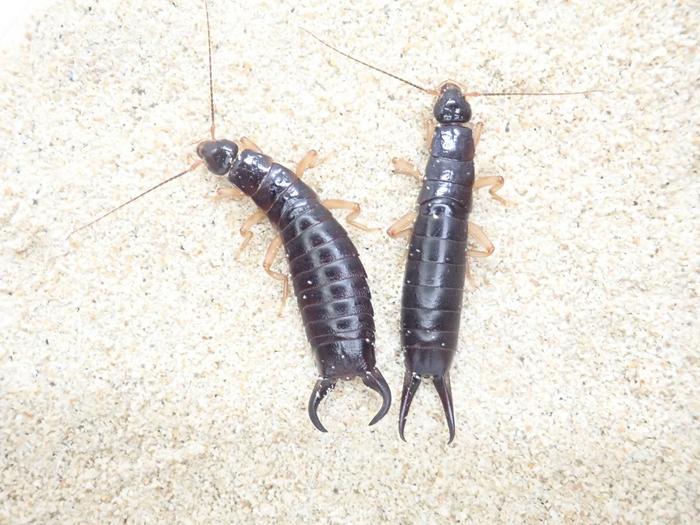In the intricate world of evolutionary biology, sexual selection has long been recognized as a driving force behind the development of extravagant physical traits, often manifesting as dramatic displays or formidable weapons among males competing for mates. Classic examples include the enormous antlers of elk, the vibrant coloration of male birds, and the oversized claws of fiddler crabs. Yet, the role of females in this evolutionary theater, particularly with regard to weaponry and exaggerated traits, remains less explored. A groundbreaking study led by researchers at Toho University now sheds light on this lesser-known facet by revealing that female maritime earwigs (Anisolabis maritima) exhibit a similar pattern of exaggerated forceps growth, a finding that challenges prevailing assumptions about sexual dimorphism and the evolution of weaponry in insects.
Sexual selection typically favors the elaboration of male secondary sexual characteristics, traits that improve their chances of winning mates or deterring rivals. This is often observable through positive allometry—a scaling relationship where certain appendages or features grow disproportionately larger as body size increases. While male elk and beetles display this phenomenon in antlers and horns, respectively, data on females have historically been sparse or interpreted as non-adaptive. The new study conducted by Toho University’s Department of Biology provides compelling morphometric evidence that not only males but also female maritime earwigs show marked positive allometry in their forceps, suggesting a more complex evolutionary narrative.
The forceps of earwigs are specialized, pincer-like appendages located at the tip of their abdomens. In males, these structures have been widely studied as weapons used during combative interactions with rivals, ultimately influencing male reproductive success. However, females also possess forceps, albeit differing in size and shape, raising questions about their functional significance. The researchers embarked on the first rigorous quantitative analysis of female forceps, comparing morphological data between sexes to elucidate potential evolutionary drivers of their form and function.
By meticulously measuring multiple body parts—including the head, thorax, abdomen, and bilateral forceps—of male and female Anisolabis maritima, the study applied morphometric and allometric scaling techniques to discern growth patterns. Male forceps exhibited classic characteristics associated with weaponry: thick, short, and curved structures optimized for gripping and wrestling during male-male competition. Female forceps, in contrast, were thin, elongated, and straighter, highlighting significant sexual dimorphism—a hallmark of divergent evolutionary pressures on the sexes.
What sets this study apart is the detection of positive allometry in the females’ forceps length. On logarithmic scales plotting body size against forceps length and width, female forceps length showed disproportionate growth relative to body size, analogous to the male pattern seen in forceps width. This indicates that female forceps development is not merely a byproduct of growth but may be subject to selective forces, potentially through female-female competition or other behavioral contexts previously underappreciated in earwig biology.
Associate Professor Junji Konuma highlights a fascinating behavioral dimension underpinning this morphological pattern: female earwigs compete for access to smaller, less aggressive males, a dynamic that contrasts with the more overtly aggressive male contests. The evolution of slender yet elongated forceps in females may thus represent an adaptation optimized for subtle but effective intrasexual competition. This nuanced view broadens the lens through which sexual selection is understood, emphasizing that weaponry and competitive traits are not confined to males.
From an evolutionary perspective, these findings challenge the traditional narrative that exaggeration of physical traits as weapons is primarily a male domain. The occurrence of positive allometry in female weaponry suggests that sexual selection can and does shape female morphology under certain ecological and social conditions. This underscores the importance of considering both sexes when investigating trait evolution, as excluding females from such analyses risks oversimplifying the diversity of selective pressures at play.
Moreover, the study exemplifies the utility of morphometrics combined with biological insight to unravel subtle evolutionary patterns. By quantifying shape differences and scaling relationships with precision, the researchers provided rigorous empirical support for a conceptual shift in understanding sexual dimorphism and weapon evolution. The implications extend beyond earwigs, urging evolutionary biologists to revisit assumptions about female trait development in other taxa where female competition might have been overlooked.
This research also highlights the value of undergraduate contributions to advancing scientific knowledge. Tomoki Matsuzawa, formerly an undergraduate, played a central role in the morphometric analyses, demonstrating how undergraduate research can contribute meaningfully to high-caliber scientific output. Such collaborative approaches foster new perspectives and invigorate fields with fresh data and methods.
Published in the Biological Journal of the Linnean Society on June 5, 2025, the article titled “Positive allometry in the forceps of the female earwig Anisolabis maritima (Dermaptera: Anisolabididae)” stands as a significant milestone in insect evolutionary biology. It prompts a reevaluation of the extent and mechanisms through which sexual selection influences females, advocating for a more inclusive framework that acknowledges intra-sexual competition beyond males alone.
The ramifications of this study resonate with broader questions in evolutionary ecology: How do ecological and social factors intersect to drive the evolution of weaponry? In what ways might female competition shape morphology across diverse taxa? As researchers continue to explore these domains, the intricate dance of evolutionary forces shaping both male and female phenotypes promises to reveal ever more surprising and nuanced biological realities.
In sum, this pioneering work not only enriches understanding of earwig biology but also has profound implications for the study of sexual selection. By revealing that female earwigs have evolved forceps with a distinct allometric growth pattern likely linked to competition, it challenges the male-centric view of weapon evolution and opens new avenues for investigating female roles in the evolutionary arms race.
Subject of Research: Animals
Article Title: Positive allometry in the forceps of the female earwig Anisolabis maritima (Dermaptera: Anisolabididae)
News Publication Date: 5-Jun-2025
Web References: http://dx.doi.org/10.1093/biolinnean/blaf031
Image Credits: Junji Konuma
Keywords: sexual selection, positive allometry, female weaponry, earwigs, Anisolabis maritima, forceps, sexual dimorphism, morphometric analysis, evolutionary biology, intrasexual competition, insect morphology




